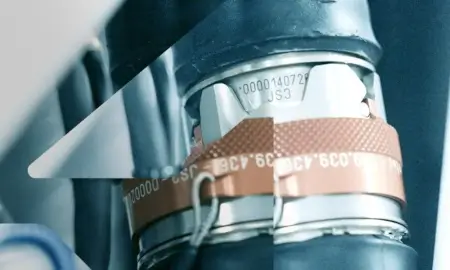December 20th 2023
Extreme E pulls back the curtain on hydrogen testing
Just one season of Extreme E remains in its current form. The 2024 campaign will be the swansong for the battery-electric Odyssey 21 before its successor, the as-yet-unnamed Extreme H hydrogen fuel cell car, will arrive.
The transition to hydrogen isn’t straightforward. There isn’t a hydrogen-powered motorsport series in existence yet, so while Extreme H has been developing a new car, the series has also been collaborating with the FIA to create new rules and safety standards for hydrogen racing.
“[It’s] very similar to all the work that’s been done in Formula 1 for many years, and of course, cascaded down to all the different championships,” Extreme E technical director Mark Grain says, speaking to media including RACER at the recent season finale in Chile. “We’re doing that work for the very first time, with it being the first hydrogen car. We’re looking at side impacts, low impacts, and impacts from the top. The chassis has been designed so the metallic element of the chassis is much more robust in that area.”
“They are still being defined in conjunction with the FIA, and they’re bolt-on parts. Again, something similar to what you’ve seen in different categories of racing. So they’ll go bolted on to the side, and they’re replaceable as well. There’s been good, solid consideration for those elements, and collaboration.”
Working out how to build and race hydrogen vehicles is one of several challenges Extreme H will face. Another is the safety stigma. It’s something the series’ managing director Ali Russell is well-versed in, having dealt with similar outside doubts during Formula E’s gestation period.
“There’s hydrogen cars in existence, but this is going to be a championship devoted to hydrogen. Hydrogen can be one of the solutions, not just for e-mobility, but actually for power, and green power,” he says. “So I think we’ve got a responsibility, we’ve got a North Star, and what we want to do is to accelerate that growth in that adoption.
“We’ve got some challenges, and the biggest one is the education system, because anytime you speak to someone about hydrogen, they talk about the explosive nature of hydrogen, and the Hindenburg and the connotations. What we’ve got to do is break that down, we’ve got to show the performance of the vehicles, but also the fact that they can be so resilient with some of the crashes that you have in this championship and multi-car championships.”
Working out how the hydrogen cars will be fueled is a key consideration as well. The paddock setup will obviously be the first of its kind, but could have legitimate real-world relevance, too.
“There’s going to be a bespoke setup in the paddock,” Grain says. “We anticipate two refueling stations, and a line of cars that will come, refuel, move, next.
“It gives us a platform to demonstrate that hydrogen refueling is very run of the mill, very straightforward. We would just have the two fueling stations out the back, which is just like a gas station these days.”
Hydrogen fuel cells could also open up the possibility of mid-race refueling, explains Russell.
“I think the challenge we’re going to have is, how do we evolve as a championship? Because obviously, what hydrogen allows us to do is to have refueling, in-race refueling,” he says. “So do you stop and do the [driver] switch and do refueling? Do you have another [stop]? How do we do that?”
While a lot of focus has, understandably, been placed on the car’s switch to hydrogen power, the evolution doesn’t end there. The new vehicle will be almost entirely new, benefiting from lessons learned in the first three (soon to be four) seasons of Extreme E racing, particularly with regard to suspension – something that underwent extensive development with the help of Fox, which came onboard during Season 2.
“The three years of [data] that we’ve got now in Extreme E, they’ve not been forgotten, They’ve been considered,” Grain says. “Spark have done an excellent job moving forward with the H car and the revised suspension geometry. They’ve worked with some technical partners in the U.S. who are experts in off-road racing as well, Baja, and so on, so [we] definitely expect improvements in the experience for the driver, geometry improvements, different damper ranges, spring ranges and so on.”
The battery technology, which will serve as a ‘buffer battery’ to temporarily store the energy produced by the fuel cell until it’s needed by the motors, will be carried over from the Extreme E cars, though. It won’t be a direct port, however, with WAE working to repackage it into something smaller and more efficient.
“They’ve done a fantastic job of repackaging technology that they’ve got,” Grain says. “So rather than being a cube, it’s more of a rectangle. All that technology is carried over, [but] there’s no compromises with having to accommodate the hydrogen fuel cell.”
Bodywork will change, and dramatically – from the large and costly components of the current car, to smaller pieces that will cut down on the vast amount of cosmetic damage the Odyssey 21 is susceptible to.
“The principles behind the large components on the Extreme E car were serviceability, so if you took a large component off, you can immediately get in work on it,” Grain explains. “What we need from our H car moving forward is bodywork that’s more modular. Smaller components, smaller sections, that could be replaced quickly; some components that are forgiving, like deformable structures around the wheel arches, for example.
“Should there be some contact, instead of breaking the piece, and then having maybe a large piece we’ve got to scrap off – even if it’s made from green material – you can see how that starts to erode the principle behind what we were trying to achieve there. So there’s going to be a lot more modular body work that’s much easier to swap smaller components out, as we now understand more about what type of racing we want.”
That type of racing has been intense, especially this season with single-car qualifying runs axed and teams running in six multi-car races over a weekend. But far from wanting to tone things down, Grain says, “we actually want the racing to be more intense”.
“We want the race cars to be faster, [have] more performance. We took some key metrics and targets from Extreme E and we set those as our absolute – we do not want to be below that. So when we’re talking about top speeds, power outputs, acceleration, and so on, that was our base minimum. In Extreme H, we want to surpass all of those.”
In terms of performance, as a starting point, the Extreme H car will be similar to the Extreme E car, despite its higher weight. It’s already meeting those benchmarks in testing, but the wholesale changes to the rest of the car outside of its propulsion system mean that performance improvements will follow naturally.
“We are capped in Extreme E, because of power delivery and angles of droop, so we limit that power delivery in Extreme E artificially – the car could run more power but we cap it,” Grain reveals. “In Extreme H, those compromises with suspension geometry have all been ironed out. So we will have a more powerful car. We believe we will easily compensate for that extra mass with the power and torque that’s going to be available.”
Of course, the introduction of a new car and new technologies will inevitably bring up concerns about costs. Extreme E in its current form is among the lower-cost top-level series, with sources indicating that budgets for a full season are in the region of $2-3 million. Russell suggests that budgets will remain in the same ballpark.
“If you look at something like IndyCar, NASCAR, Formula E, they’re $20-30 million to run the teams in those championships,” he says. “What we want to be is a low-cost option, but with the focus around the development of hydrogen technology, specifically around the fuel cell.”
Series founder and CEO Alejandro Agag says that after a year or two the rules could be opened up to allow fuel cell development, something that could lead to a slight increase in costs, but it won’t be anything insurmountable, and perhaps not even worthwhile.
“It will make it a little bit, but not that much, because they will already have the fuel cell developed for other uses,” Agag insists. “So I think it will increase the cost, but the base car – or the customer car, if you want to call it that – will be ours. The one we’ll provide with Spark that will be available, and cheap.
“It will make it a little bit, but not that much, because they will already have the fuel cell developed for other uses,” Agag insists. “So I think it will increase the cost, but the base car – or the customer car, if you want to call it that – will be ours. The one we’ll provide with Spark that will be available, and cheap.
“If they want to increase, I don’t think the gains on performance can be so huge,” he says, suggesting that the only real benefit would be brand recognition that could come from using in-house tech.
After initial systems tests since the summer, this week the first full Extreme H prototype undertook its first shakedown. It marked a first major milestone for the car, which will be tested further in the first half of 2024.
“We’re up and running, we’re not this ethereal thing,” Grain says. “We’ve got a real car and it runs. We’ve got an extensive test program planned for Q1 and Q2 of next year.”
Russell adds that next season’s Extreme E calendar will also tie into that testing program, with a European-focused schedule that will allow testing and races to run in parallel.
“What you’ll see is [that] next season is very much about transition,” he says. “So what that means is we are really going to be focusing on a lot of European locations, because what we want to do as well is test the H cars.”
Extreme H’s 2025 arrival is very much on course, keeping to a timeline that other proposed hydrogen motorsport projects haven’t been able to.
“We’re going have the first, and I think for quite a while the only pure hydrogen World Championship racing,” says Agag. “I think all the other plans with hydrogen everywhere are very delayed. You’ve also seen Le Mans, they were going to do a car but delayed it.
“Our car is running, we’ve been doing all the tests in France, we’re going to test for another three months, but everything is up and running. Everything is going good performance-wise, to reliability-wise, and safety-wise.
“So we’ll start making the cars and we will have a hydrogen car race in February 2025.”
For more information: www.racer.com













